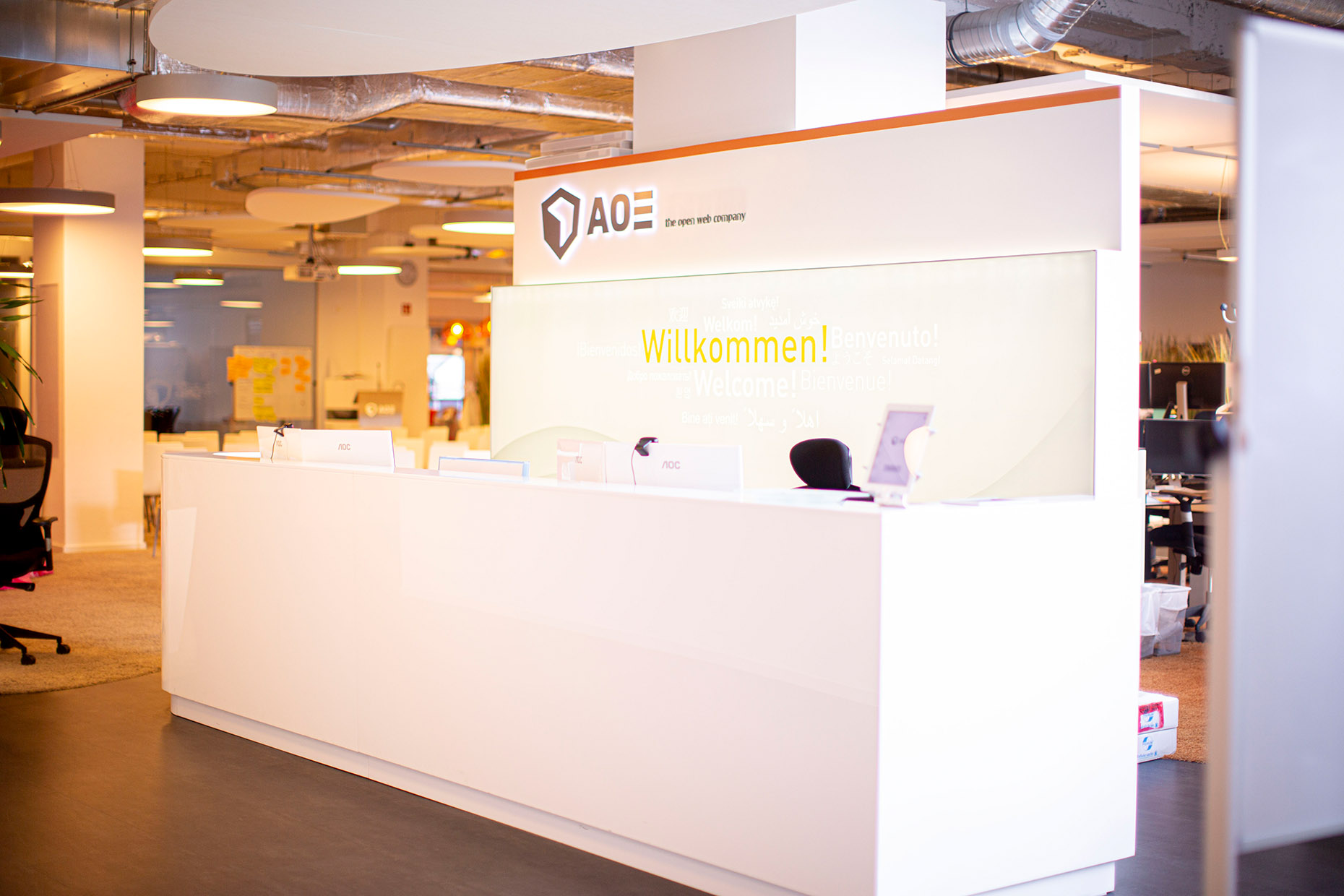Get in touch
Corona is a massive threat to our health and our economy. We are currently heading for an unprecedented crisis with open outcome. However, necessity is also the mother of invention: home office and remote work are currently experiencing a real boom. In the shortest possible time, companies are able to handle what would other-wise take months of preparation: Home office for complete teams, departments or even the entire company, as here at AOE in Wiesbaden. But of course, it's can't all be accomplished simply by deciding to do work from home from now on. In a conversation, COO Joern Bock, expert in New Work and Self-Organization, tells us how AOE has mastered the transition to Remote Work – both technically and on a human level.
Hi Joern, where did we catch you and how are you doing?
I'm fine, thanks. I'm currently in the home office, but everything is still a bit provisional. As the schools have been closed since Monday, I left my actual office to my wife and kids for homeschooling. But everything is running smoothly and I am fully able to work – even in the basement, where my desk is currently located.
When exactly did AOE management make the decision to switch completely to Remote Work?
AOE has a number of customers from the Asian region, so even at the beginning of the Corona crisis we had a relatively large number of insights. I must admit, however, that at that time we tried to keep calm and watched the development from a distance. At the same time, of course, we planned emergency measures, such as a remote fitness check with each team. This check included, among other things, a data security check of every computer and the preparation for two test runs.
However, after the situation had massively worsened in recent weeks, it became clear that we cannot wait too long to react. Consequently, we brought carried out the 2 test runs earlier than planned and at short notice, namely a 50% remote outsourcing of employees in the first step and then a 100% for the following day. The 50% test run ran smoothly, so that we then ran the 100% as a reality check the following day, thank God there were no problems.
And how long did it take until all employees had actually arrived at their home offices and were able to work again?
We switched to home office without any loss of performance and without any delay, because some teams had already worked remotely many times and we had planned well in advance. We had a small challenge with the administrative teams, such as HR or Finance, which had not consistently had a remote setup before. This week we had to maintain on-site emergency staffing in the administration department and in the kitchen of our Eatery. But from next week on, we will no longer offer emergency staffing.
From your point of view, what worked out well in the switch to remote work and what was rather difficult?
As already mentioned, the move of the development teams worked well and they were immediately ready to work. On-the-fly, however, we still had to replace some remote tools or buy extended licenses due to the suddenly vastly increased number of users. But this all went very quickly and smoothly, as we were able to act spontaneously without any major approval processes.
We are currently testing various virtual office tools and are using various remote conferencing tools. One topic we are currently still working on is on optimization. The different teams all have different preferences. Currently, the plan is for the respective Scrum Masters to decide with their teams what works best for them and what makes the most sense. In any case, we need much more sync than before and for this reason we have created different sync workgroups.
Have you been able to draw specific lessons for yourself from the process, what would you perhaps do differently in the future?
In any case, it was important that we started to monitor the situation in Asia closely at a very early stage, set up a crisis management team in a timely manner and planned emergency measures. However, it was not possible to foresee that the situation would deteriorate so rapidly, so we simply decided on a daily basis. Some employees may have felt that we acted too hesitantly in one place and too quickly in another, but I am convinced that - given the very dynamic situation - we took all the decisions at the right time.

Very practical questions: How is the cooperation between the development teams currently going? And the communication with the customer?
Fortunately, the cooperation of the developers is running very smoothly. The company is at its normal “value added” level and the Scrum masters aren't reporting any problems. Where we still need to gain experience is with the onboarding of new employees as well as with the syncs.
The rest of the organization must also find its groov. I am currently experiencing this first hand, my working day is much more stressful than before, as I have to make all the arrangements by telephone that were done previously more or less in person in the office. I am in calls almost around the clock. But I think that even those work areas that currently still have difficulties imagining how remote work will proceed will learn to organize themselves over time.
Communicating with our customers is running like before. We’re all in the same boat. Meetings and coordination simply take place virtually, and it’s working smoothly.
There are, of course, employees who cannot work remotely, such as the cooks or the masseuse or the colleagues at reception, who takes care of these employees and are there currently tasks that they can do alternatively?
The masseuse can of course no longer carry out her regular activities, since she must keep the minimum distance. She and her colleagues from reception have joined forces to form a "Team Office-Admin" and now want to work step by step on tasks that have always taken a backseat due to the regular workload. The kitchen has been reduced to one person this week and the colleagues will reduce their holidays to support the company. We are very grateful for this. From the coming week on, there will be a complete office shut-down, i.e. all employees will work from their home offices with very few exceptions.

Now to the technology: Which tools and which technology are being used to make remote work possible without any hitches? Do you have favorite tools, which have proven to be particularly useful?
Our development teams have long since virtualized their development environments so that they can work locally almost anywhere. Gitlab, Artifactory, Docker, Kubernetes are some of the tools I would like to mention here as examples. A more detailed overview of the tools and technologies we use can be found on our AOE Tech Radar.
In addition to actual development, we are also intensively examining tools for the communication of distributed teams. Currently, we use Highfive, Zoom and Sneek for our web conferencing. This depends on the use case and the preferences of the teams. We have been using Mattermost for internal communication for a long time and have many tools available for collaborative work on documents, such as Confluence, DropBox Business, Google Drive or virtual whiteboards from Target Process.
In these difficult but very special times, many people complain not only about the fear of illness and uncertainty, but also about the increasing loneliness caused by isolation in the home office. Do you have a plan to raise the spirits of the employees?
We use video conferencing very intensively, i.e. people see each other. This often leads to very funny and personal incidents, for example the cat jumps on the desk or the children appear in the background. We are currently planning various contests, for example, who has the best hairstyle or the best outfit or the best coffee mug during a video call in the home office and we chat with each other quite often. So that we don't "lose" individual employees, the Scrum Masters plan regular virtual meetings for the teams. We don't expect any problems with the teams that have already worked remotely on a regular basis. However, for teams with little or no remote experience we will take a closer look.
Would Remote Work be conceivable as a permanent state for AOE as a company?
We can now test this extensively and gather our own experience. AOE is an on-location company, we value face-to-face communication, we live and work together. How much "remote spices" can this soup take? Personally, I believe that a balanced relationship between Onsite and Remote is the right recipe for AOE. Of course, this must be decided on a case-by-case basis. We search and find our talents all over Germany, or have employees who often have to work from home due to their personal situation, and these can only be closely linked to AOE (in the sense of employee loyalty and commitment) through a sensible remote culture. AOE is a pioneer in many areas, but one shouldn’t run in the direction of remote work full steam ahead without reflection. We’re technically capable of enabling the entire company to work remotely, we’re capable of delivering and productive, and now we're just trying to make the best of the current situation. From the very outset, we have made it our goal to learn as much as possible from the current situation. On a team level, on a personal level, but also as a whole organization. Our goal as AOE is to come out of the situation stronger and more mature. Thus, the corona crisis, despite all of the imponderables, provides us with the opportunity to test remote work and learn in the process.
Joern, thank you very much for your time and insights.